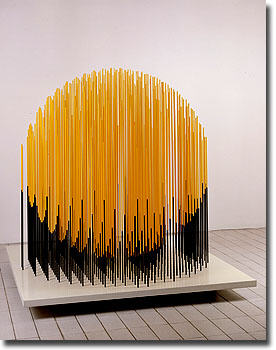Museum of Latin American Art ,
Nov 20, 2005 - Aug 01, 2006
Long Beach, CA, USA
Jesús Rafael Soto: The Universality of the Immaterial
by Beth Rosenblum
The next section of the gallery contains panels about Soto’s relationship to architecture and the Museo de Arte Moderno Jesús Soto in Ciudad Bolivar. The panels are accompanied by photographs of large-scale site-specific sculptures, and another virtual object, Cubo Virtual Azul y Negro (1983), which is suspended from the ceiling. These works are integrated into the architecture, either mounted on the walls as kinetic murals, or hung from the ceiling. They too are virtual objects composed of rods made from various materials, and painted to form assorted shapes. Those featured include, Mural at Teresa Carreño Cultural Complex (1972-1982, Caracas), Kinetic Murals (1969, UNESCO, Paris), Virtual Volume (1987, Georges Pompidou Centre, Paris), and Big Sphere in Seoul (1988, Seoul). The final segment of the didactic gallery contains a family area with interactive panels and a television playing the film "Does Penetrable Light Exist?"
Placed midway through the exhibition, the family gallery acts as a segue way rather than a stopping point, and the exhibition continues into the adjacent gallery, which contains sixteen works produced between 1959 and 2003. The pieces displayed here reveal Soto’s preference for including a calculated black and white striated segment in his work that served as a base or backdrop for three-dimensional metallic objects.
The earliest piece in the exhibition, Sin Titulo from 1959, demonstrates Soto’s use of this strategy. On a square piece of wood painted black, Soto inscribed the white outline of another square that mimics the shape of the support. This interior square is split in half, of which one half is left black, the other painted with narrow white vertical lines. Protruding from the striped pattern are a metal square and pieces of metal wire placed diagonally across the surface. The support of this work, like most of the pieces included in this room, is made of wood, an organic material. The wooden support is juxtaposed with geometric lines, meticulously calculated to impose a rational order upon the organic structure.
A highlight of the exhibition is Vibración from 1965, which similarly contains black and white striations. This pattern fills six squares arranged in two columns of three. Each of the squares contains four small metal squares that project out from the surface, arranged two by two. As the viewer walks by the work the metal squares appear to vibrate, inviting one to move back and forth in front of the piece. Here, as with most of Soto’s work, there is tension between stasis and movement. The vibrating effect is based entirely on optical responses to a stationary surface. The optical illusion completes the work, yet only exists in the viewer’s mind. All of the artwork included in this gallery, with the exception of the sculpture in the center of the room, share elements with the two pieces described. In later works, color begins to play a role in the form of painted metallic squares and wires.
The artwork in the exhibition is grouped thematically, however, a chronological grouping of the works and the inclusion of Soto’s early works would have produced a stronger and more comprehensive display. Many of these works, such as his Penetrables series - which are critical to understanding the trajectory of Soto’s work--are mentioned in the numerous text panels, but would have made a greater impact in person. Overall, this small-scale exhibition is an informative look at Soto and his work, serving as an introduction for the novice, and for those familiar with the artist, a chance to view his innovative works firsthand in this country.
Notes:
1) This description is based on Milagros Bellos’ found in her essay for the exhibition catalogue, "Jesús Soto: The Destruction of Site." Soto: The Universality of the Immaterial (Museum of Latin American Art, 2005), 16.
2) Alfredo Boulton, Soto: Space Art (Milan: Antonio Cordani, 1985), 14.
3) For more information see Kirsten Hammer Dueck, "A Universal Calling," Soto: The Universality of the Immaterial (Museum of Latin American Art, 2005), 15.
|











